The Samsung Galaxy Note5 and Galaxy S6 edge+ Review
by Joshua Ho on October 2, 2015 8:00 AM ESTBattery Life
Battery life is undoubtedly one of the most important parts of the user experience of any mobile device. One of the major reasons why many people use phablets is to get better battery life, as the PCB size of a phablet is often roughly similar to what you’ll see in a smartphone, but the battery will be bigger to fill the available space. As a result, a phablet has a higher proportion of battery than a smartphone. This inherently means that battery size will scale faster than platform power. In order to test this metric, we use a number of different tests ranging from display-bound web browsing to SoC-bound CPU and GPU load tests. In order to eliminate confounding variables, we test all devices from the same ASUS RT-AC68U router for WiFi testing, and in strong LTE/3G reception for mobile web browsing, in addition to setting all devices to an average of 200 nits on the display.
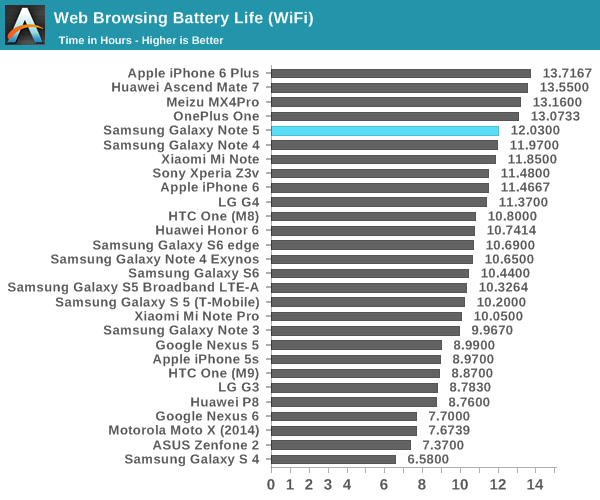
In our first test of WiFi web browsing, the Galaxy Note5 performs identically to the Galaxy Note 4. This might be surprising because the display is the same size and resolution as the Galaxy Note 4 with a smaller battery than the Galaxy Note 4. However, the smaller battery is compensated for due to improvements in SoC and display efficiency. In particular, the move from a planar 28nm process to a 14nm FinFET process dramatically reduces power consumption on the SoC.

In LTE battery life, we see a noticeable drop relative to WiFi battery life. It’s likely that this is mostly due to the power consumption of the Shannon 333 modem present in these devices. There’s not much else to say here, but battery life is still good.
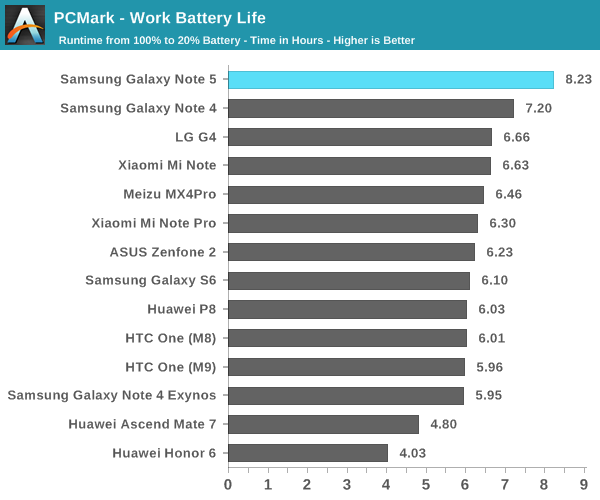
Moving past our mostly display-bound web browsing test, PCMark provides a much more balanced look at battery life as APL tends to vary a bit more with content like videos and photos instead of just webpages, and the CPU component is much more strongly emphasized. Here we can really see the Note5’s Exynos 7420 stretch its legs as it keeps a high performance level with long runtime.
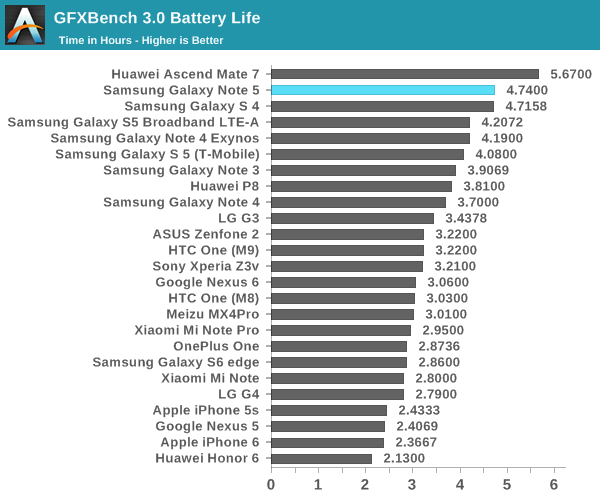
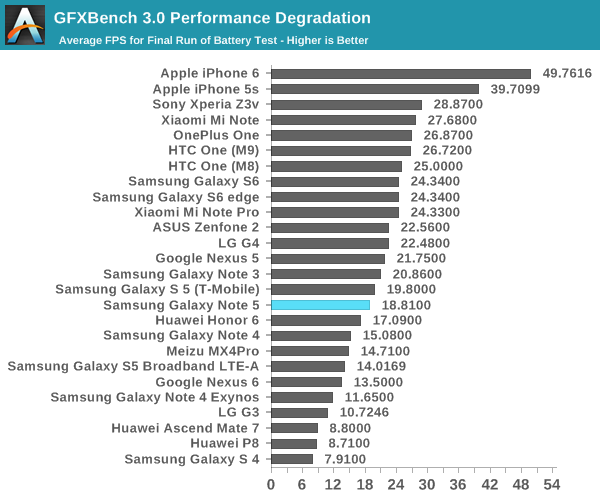
In our sustained SoC-bound workloads, GFXBench shows a healthy improvement over the Galaxy S6. Although we’re unable to test in perfectly controlled temperatures, it looks like Samsung has improved the throttling behavior of the SoC as the throttling appears to be more graceful rather than sinusoidal, and the result is a pretty significant jump in runtime over most devices.
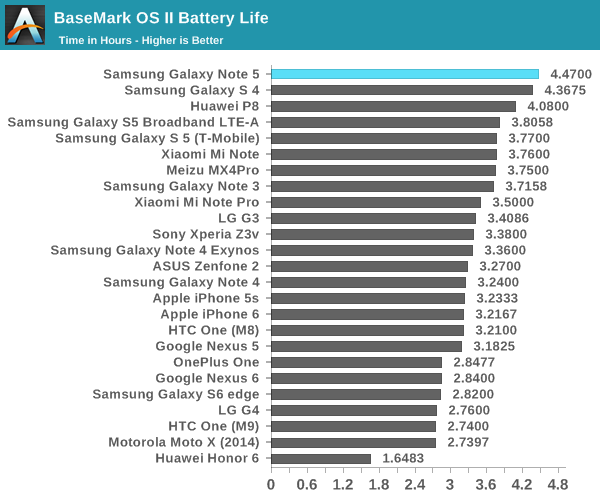

In Basemark OS II, we see a pretty significant uplift in runtime when compared to something like the Galaxy S6 or Note 4. The runtime increase isn’t just due to excessive throttling though, as the battery score shows that this isn’t just a case of throttling the CPU until the runtime is an improvement over past devices.
Overall, if you’ve read the Galaxy S6 review it’s pretty fair to say that you’ll know what to expect from the Galaxy Note5. Battery life is roughly equivalent to the Galaxy Note 4 despite the smaller battery, and due to the greatly improved Exynos 7420 SoC relative to 2014 SoCs SoC-bound cases will show pretty healthy improvements as long as you’re controlling for performance.
Charge Time
While normally battery life is the primary area of concern for a smartphone, in some cases it’s important for a phone to charge quickly. We can all claim to be perfect but one of the simplest cases for faster charging is forgetting to plug the phone in before going to sleep, so the maximum allowable charge time goes from something like 6 hours to an hour at best. As a result, a faster charger can dramatically improve practical battery life in any situation where you have limited time to charge. This can be accomplished by increasing either the current or voltage of the charger. The original quick charging standards improved charge rate through higher current, but this eventually hits a wall due to resistance in the wire. In order to increase the total amount of power delivered without increasing the thickness of the cable used voltage was increased in the case of newer standards like QC 2.0. In the case of the Galaxy Note5 and Galaxy S6 edge+, we’re looking at the same 9V, 1.67A QC 2.0 compatible charger that shipped with the Galaxy Note 4. In order to test this properly, we log the time it takes for the phone to charge by running a timer until the charger power draw hits a point that represents 100% battery.
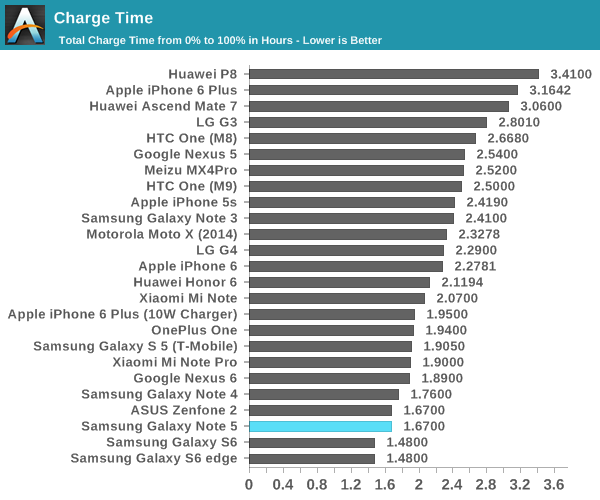
It probably isn’t a surprise, but charge time ends up similar to the Galaxy S6 and Galaxy Note 4. I suspect that we’ll be waiting until QC 3.0 to be able to see significant improvements as the current standard doesn’t have particularly fine-grained voltage scaling according to cable and phone conditions. Interestingly, the wireless fast charger is actually not too far off from the wired charger as it indicates 100% around 1.84 hours into charging which is almost identical to the wired fast charger.


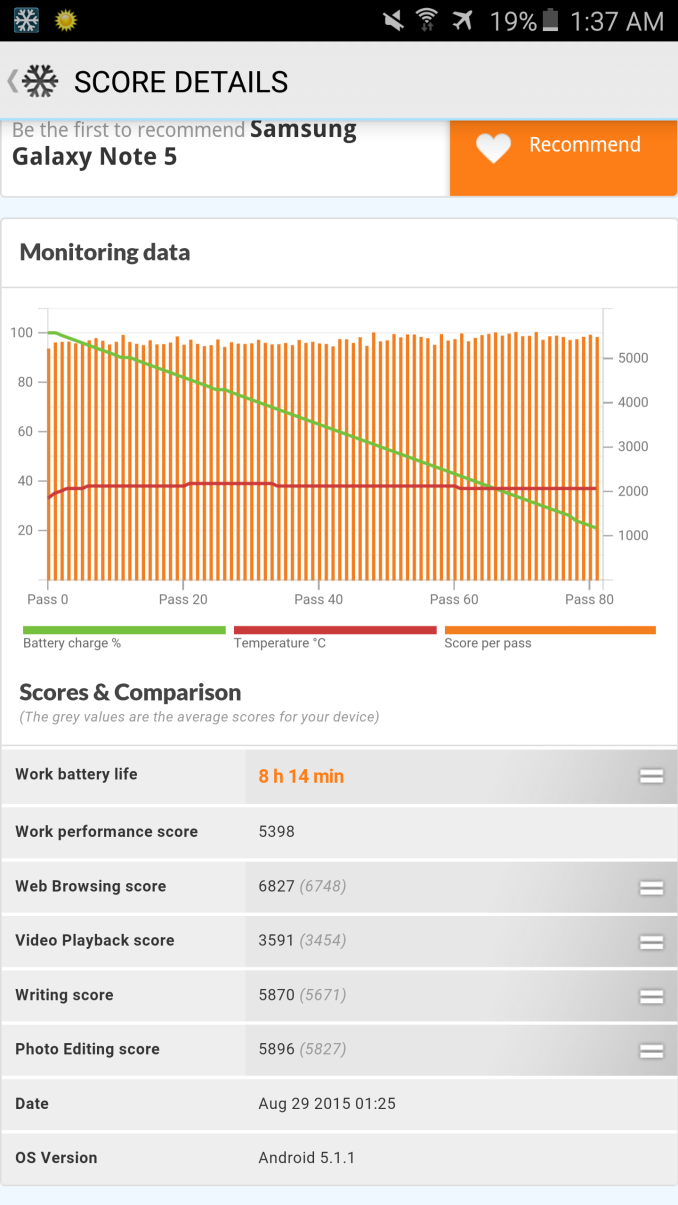
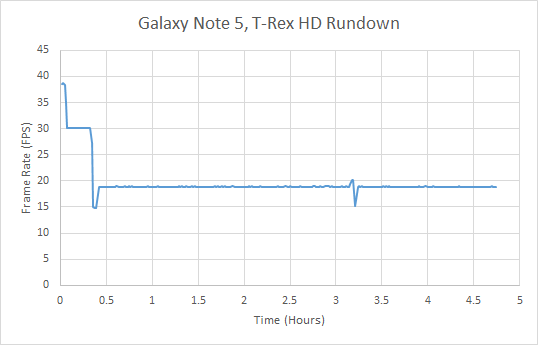
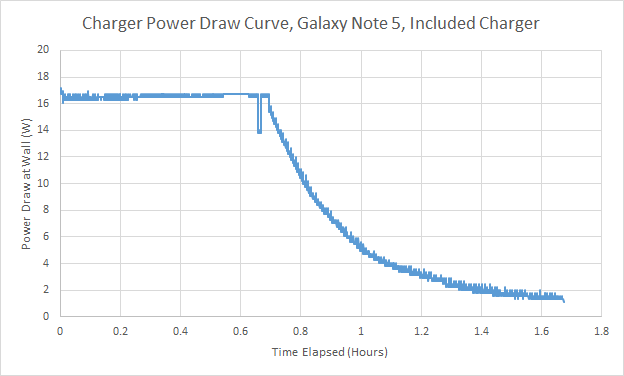
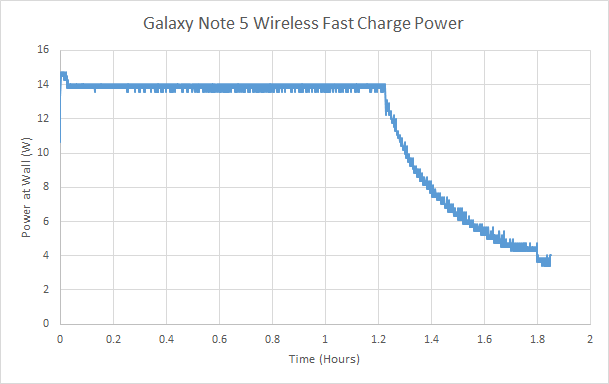








225 Comments
View All Comments
ciderrules - Tuesday, October 6, 2015 - link
Funny you picked the iPhone 6S and not the 6S Plus, which is a better comparison due to it having a larger screen and more "pixels to push".It scored 85 hours on their endurance rating, easily beating the GS6's 73 hours. Further, the 6S Plus beat last years 6 Plus even with a smaller battery. GS6 actually had less battery life than the GS5.
So Apple gives you the most powerful processor on the planet, decreases the battery size by 8%, and manages to increase battery life.
Kuzi - Tuesday, October 6, 2015 - link
iPhone 6s Plus is a phablet the same size of the Note 5, so should be compared with the Note 5 which gets the same rating of 85 too, but is pushing 1.7 times more pixels while offering faster multithreaded performance.ciderrules - Tuesday, October 6, 2015 - link
No, it's not faster. I already explained this to you before and you're still coming back and posting incorrect information again?Primate Labs (makers of Geekbench) rates the Note5 at 4351, the iPhone 6S/6S Plus at 4330/4331. So yes, the Note5 is a fraction of a percent faster in multi core performance.
Kuzi - Wednesday, October 7, 2015 - link
How many times do I have to explain that I own a Galaxy S6 and I get +5200 on Geekbench multicore test. I also own an Xperia Z4 tablet (SD 810 based) that gets +4800. So both are faster than A9 in multicore.Also GSMArena & Phonearena get similar results for exynos 7420 based devices as per below:
http://www.gsmarena.com/samsung_galaxy_note5-revie...
http://www.phonearena.com/news/Our-Samsung-Galaxy-...
There is some variance with each test run, and if the phone is warmer it gets slightly lower results. In my case the lowest I got was 5000 for GS6.
thedons1983 - Sunday, October 18, 2015 - link
What a fucki#g moron. You are pathetic!!coburn_c - Sunday, October 4, 2015 - link
Both curves of the plus have a disgusting green hue to them, and when you tilt it until one disappears, the entire front gets the baby poo greens. It is easily the worst viewing angle on any modern phone, and on an AMOLED of all places, a technology known for its viewing angles. I can't imagine how they could have screwed up worse.thedons1983 - Sunday, October 18, 2015 - link
Then you lack imagination... Apple has already made a worse phone for starters, or are you so ignorant, that you can't tell the difference between apples and oranges????theduckofdeath - Monday, October 5, 2015 - link
I wonder why Anandtech still had one standard for Samsung and one standard for everybody else when it comes to displays? I don't see you people scrutinise and down rank ocular quality issues with LCD displays like to do with AMOLED. AMOLED haven't just caught up to LCD this year, it's been superior for years, Anandtech. Fix your flawed and biased tests.Peichen - Monday, October 5, 2015 - link
If AMOLED is anywhere close to IPS why aren't EIZO, NEC, Dell switching their professional lineup to AMOLED? Why are 31" calibrated IPS monitors going for $3000 while the same money can get you 55" 4K OLED TV? For that matter, how come no one is selling a calibrated OLED anything? With all the green/purple tint and grayish white you'd think OLED could use some calibration.Leave the review to the professionals. Your eyeballing review aren't worth the hot air carrying the sound bits.
Kamus - Tuesday, October 6, 2015 - link
"The professionals" agree with him, go read displaymate's reviews.